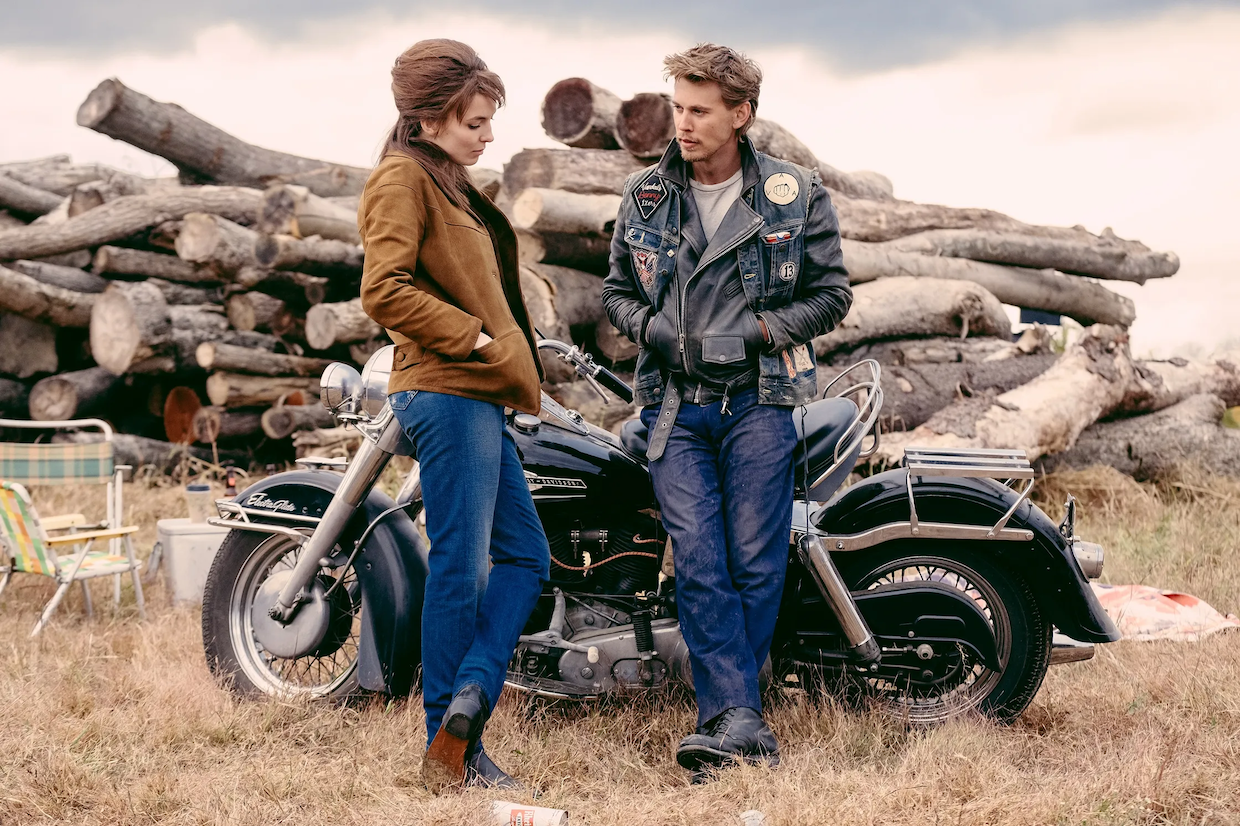The Bikeriders” has an all-star cast, with Jodi Comer, Austin Butler, Tom Hardy and Michael Shannon. The movie is inspired by a photo book of the same name by Danny Lyon, written in 1968. Jeff Nichols “Loving” (2016) wrote and directed the script. The movie takes place near Chicago and tells the beginning of a group of motorcycle friends who form a gang named the Vandals. Butler is a wild child and has several scrimmages with violence at the start of the film to set up his character. He meets Comer and is smitten. They soon marry, and they navigate their lives according to the road map that bike leader Tom Hardy sets out. The performances are noteworthy, along with the authentic period dialogue that sets the tone.

The film charts the rise and fall over ten years of the Chicago suburb-based Outlaw Motorcycles Club, which ultimately changed from a local riding club to a disturbingly violent gang. The club’s founder and leader, Johnny (Tom Hardy), struggles to enforce the rules he’s making; Benny (Austin Butler) is his captivating but dangerously unpredictable follower; it’s Kathy (Jodie Comer), the wife of Benny, who has the club all figured out—she thinks they’re all idiots. She’s written as a strong-willed character in a yin-yang situation with Benny as he gravitates toward Johnny, somewhat of a father figure. Nichols has said this is not your typical love triangle in which two guys are vying over a girl; he thought it would be interesting for a woman, Kathy, and the club leader, Johnny, to fight over a young man, Benny.

By blending comedy, violence, and moments of tenderness, Nichols crafts a modern gangster story that stands out for its unique perspective-it’s a biker film told from a woman’s point of view. This fresh take is a reason to champion the film, as it allows Kathy to shine as a strong woman and a role model. The screenplay empowers her to stand up for her beliefs, make her own decisions, and solve her own problems, without relying on a male savior.
Looking back from a woman’s point of view and my experiences with motorcycles growing up in Los Angeles, I realize that motorcycles were standard; their presence was like no other on the highways, especially the 405 freeway. My father would remark, “Watch those bikers for me, kids,” as he was always on high alert with his driving when they were close to his family, as the bikers were known to dart in between traffic. As the oldest of five, he usually depended on me as a lookout. Seeing the Hells Angels riding together was an ominous sight to behold, as their ultra-loud sound is both deafening and exciting. What fascinated me were their black leather jackets with their iconic logo, very cool black leather biker hats, and leather side-fringed pants.
Undoubtedly, this is a male-centric story, focusing on a club or brotherhood that prioritizes mutual protection. The women of that era had distinct roles, often riding on the backs of the bikes, preparing meals, and caring for the children. They were not part of the inner circle or decision-making. However, Kathy breaks this mold. She is a strong female character, a beacon of self-sufficiency, and a progressive role model, not in need of a male savior.
During my Zoom interview with Jeff Nichols, I asked him why he wanted to tell this story from a woman’s point of view. He said that the ultimate truth is Kathy is the most interesting person in the book. He fell in love with the way she talked about herself, her relationship with Benny, and her relation to the club, including the biker guys. She was funny but also shockingly honest. There was no filter. It could be who she was then or because she talked into Danny Lyon’s reel to-reel tape recorder. Another reason she’s the perfect person to view this club and these people is that she is both an outsider by the benefit of being a woman and an insider because she is intimately involved in this club. So, with hindsight, only a woman could have this special kind of access.
Comer’s work here is impressive as she’s the one so often with the moral and intellectual upper hand. Nichols said, “That is one of the best parts of that love triangle in that relationship dynamic. This woman is sitting there dealing with these men who can do amazing things and can be incredibly beautiful, attractive, and alluring. Still, they need help to do simple things in terms of understanding themselves or enunciating themselves, particularly when talking about their masculinity.”
I find it fascinating that Nichols has such an astute consciousness of women in his writing. As Johnny, a man of few words, is shown to solve most of his problems with the club through violence or intimidation, he’s totally at a loss for words, shocked that a woman would confront him. It’s both enlightening for women and perceptive to see that women can sometimes cut to the chase despite men’s macho exteriors.
As a female film critic with over 20 years of experience, I always appreciate when filmmakers incorporate more women into a film’s storyline, particularly in a film like this where the male characters dominate. Kathy is a shining example of a strong, positive, independent female character, willing to go the distance for her husband’s well-being and her own safety. Her character represents the untold stories of women in motorcycle clubs across the country, making her role in the film all the more significant.
The full article is posted to RogerEbert.com, where I discuss my interview with Peter Fonda during a fan event for the movie “Easy Rider.”
